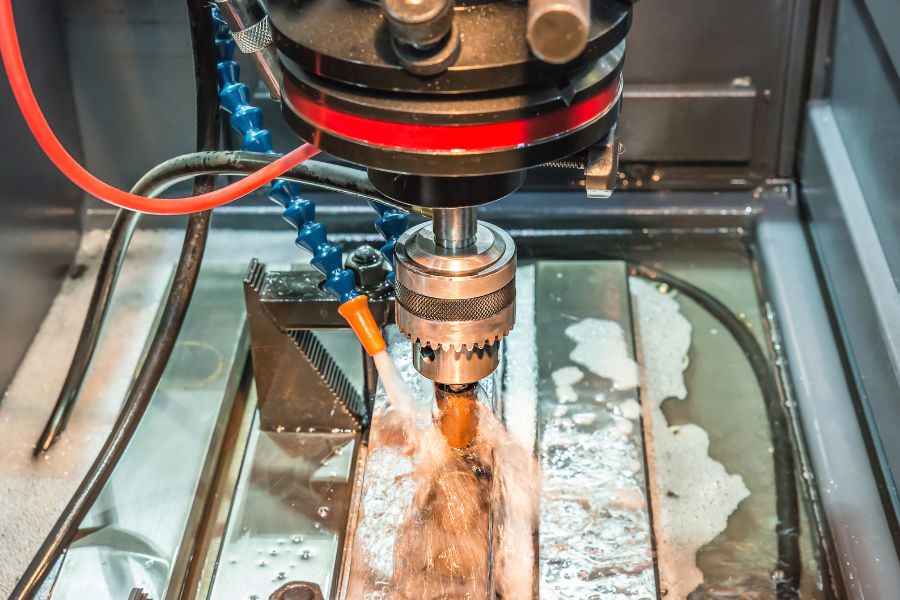Fluids are used in various industries and applications, but the manufacturing industry uses cutting fluids more than any other sector. Machine shops, manufacturing facilities, and anywhere else where metal parts are cut or machined use cutting fluids to ensure the process runs smoothly and safely. But what exactly is cutting fluid? And which type of cutting fluid should you be using in your application?
This guide will answer these questions and more so that you know everything you need to know about cutting fluids and how to choose the right machining oil for your application.
What is Cutting Fluid?
A cutting fluid is a specialized coolant for machining. The main purpose of these fluids is to provide lubrication and cooling of a tool bit as it moves through metal, plastic, or wood material during machining operations. Without cutting fluids, machines would be unable to produce parts without severely damaging or breaking their tools.
Different types of cutting fluids are available on the market based on different characteristics, such as the type of work they are used in or specific applications they may need. Here is how cutting fluid offers lubrication and cooling functions
Lubrication
Lubrication involves reducing friction and wear between two or more surfaces. This is achieved by introducing a fluid between two parts that are rubbing against each other. The lubricant is usually a liquid or a gas, but it can also be a solid such as graphite.
When applied correctly, cutting fluids act as a lubricant in machining operations; therefore, they reduce metal-to-metal contact between tools and workpieces, thus preventing excessive wear on machine components and tooling.
Cooling
Cutting fluid also acts as a coolant in machining operations. Coolants are used in metal-cutting processes to lower metal temperatures, leading to more accurate and consistent tooling cuts.
Coolants also prevent surface rust on steel parts that have been cut, which improves part quality and prevents corrosion of parts during storage.
Cutting Fluid Properties

-
High Flash Point
This is one of the most essential properties of cutting fluid. It is a measure of how easily a liquid will ignite and burn. The high flash point means it takes more heat energy to start a fire, so there is less chance of fire or explosion.
-
Low Viscosity
Viscosity is a measurement of how thick or thin a fluid is. If you have ever tried to pour syrup out of its container, then you know what viscosity feels like. A low-viscosity fluid pours easily and flows freely, which helps keep your machine clean by removing chips quickly before they can build up in hard-to-reach places.
-
Low Surface Tension
Surface tension is how much energy it takes for a liquid to form a film on its surface. A low surface tension means that liquids spread out easily and cover a large area, which helps keep your machine clean by removing chips quickly before they can build up in hard-to-reach places.
-
Stableness at High Temperatures
While cutting fluids are designed for use at high temperatures, they should be able to maintain their chemical makeup over that range of temperatures. A stable fluid will provide consistent performance during your entire machining operation.
-
High Heat Absorption Rate
The heat absorption rate measures how quickly a fluid takes on energy. A high absorption rate means that fluids will absorb more energy in a short time and spread it out over a long period.
-
Great Lubricating Properties
The main purpose of a cutting fluid is to lubricate your machine, so great lubricating properties are essential. A cutting fluid with high lubricating properties won’t wear down as quickly or easily, saving you money in maintenance costs over time.
Cutting Fluid Application Methods

-
Flooding
Cutting fluid is applied to a machining operation as a flood. The machine is stopped and flooded, then started again. Flooding is used when large surfaces are machined, or chip control is not essential.
-
Mist Application
Cutting fluid can be applied as a mist when mixed with gas. The machine is running, and cutting fluid is sprayed over the workpiece. Mist application provides chip control and helps prevent tool wear.
-
Jet Application
This uses cutting fluid as liquid or gas. A stream of high-pressure air is used to atomize a fine spray of cutting fluid. Jet applications help reduce tool wear and provide chip control. It also reduces spatter and cools down tools.
Types of Cutting Fluids
There are various types of cutting fluids, and each has its tradeoffs. Fusion offers a variety of durable and stable metalworking fluid products.
-
Straight Oils
This type of cutting fluid is designed for general machining applications and is usually a petroleum-based oil. Straight oils are inexpensive, non-toxic, environmentally safe, and easy to dispose of. They provide maximum lubrication at ambient temperatures and have good thermal stability. They have low viscosity that provides efficient heat transfer from tool to workpiece, which reduces heat build-up in tools.
These fluids do not contain any antiwear additives or other special additives such as rust inhibitors or extreme pressure additives. Although they have poor cooling characteristics, straight oils can be used successfully with most cutting tools.
-
Soluble Oil
Soluble oil possesses emulsifiers which are added to enhance their water-washout characteristics. This type of cutting fluid is used for machining operations where there is a possibility of creating water-soluble compounds such as molds, dies, and castings.
They have good cooling characteristics and can provide efficient heat transfer from the tool to the workpiece. However, they’re only ideal for nonferrous materials because they do not have rust inhibitors or extreme pressure additives.
-
Synthetics
Synthetics is an oil-free cutting liquid with organic, polymers, and inorganic materials. They have longer shelf-life since they lack oil which can deteriorate with time.
This type of cutting fluid has good thermal stability and is resistant to oxidation. They have high viscosity, which provides maximum lubrication at ambient temperatures, and low viscosity, which provides efficient heat transfer from tool to workpiece, which reduces heat build-up in tools.
-
Semi-synthetics
This is used for corrosion resistance, lubrication, and tolerance against contamination. It is ideal for both non-ferrous and ferrous materials. They have good thermal stability and can provide efficient heat transfer from the tool to the workpiece, reducing heat build-up in tools.
How to Choose the Right Machining Oil for Your Application

Choosing the right machining oil for your application is a crucial step in ensuring that you get consistent, quality results. However, there are so many different types of machining oils on the market that it can be difficult to know which one is best for you.
To make things easier for you, here’s a quick breakdown of some important considerations when choosing machining oil:
The Machinability of Your Material
Every material has its own specific set of characteristics and properties; as such, each material will require a unique combination of properties from your cutting fluid to ensure optimal performance.
For example, if you’re machining a particularly hard material like steel, you’ll need an oil that provides better wear resistance than oil that is used for machining aluminum or copper.
The Cutting Fluid Type
You also need to choose the right fluid type. There are many different types of machining oils on the market, including synthetic, semi-synthetic, and mineral oils. Each type has its unique set of properties; as such, it’s important to choose an oil that is designed for your specific application.
Machining Speed
The speed at which you are machining your material is also crucial. If you’re machining very quickly, you may need an oil that provides better coolant or rust protection than oil used for slow machining.
Understand Your Operational Types
One of the most important considerations when choosing an oil is understanding your operational type. This will help you select a type of oil with properties and characteristics ideal for your operation. For example, if you’re machining relatively large components, you may need a more high-viscosity oil than oil that is used for machining small parts.
Disposing of Machining Oils and Environmental Impact
Disposing of machining oils can impact your business and the local environment. When you’re done with machining oil, ensure it doesn’t end up in a landfill or contaminate groundwater. Basically, the impact gets lower when the cutting fluid is reused. Therefore, the best way to dispose of machining fluids is by recycling them.
The EPA recommends that companies reuse their used machining fluids whenever possible. If they cannot do so, they should send them off for recycling at a hazardous waste disposal facility that accepts used machine coolants. Companies should never dump old machine coolants down storm drains, sewers, or toilets because they could contaminate groundwater supplies.
Final word
In a nutshell, cutting fluids are essential for any machining process. The fluid helps cool and lubricate your metal as it passes through your machine. There are several different types of fluids available depending on your application and preferences. Also, no one type of fluid will work best in every situation, so choosing which one is right for you will depend on how you want to use it and where you’ll be using it.
Hopefully, this guide has given you some ideas about choosing a good machining oil for your specific needs.

